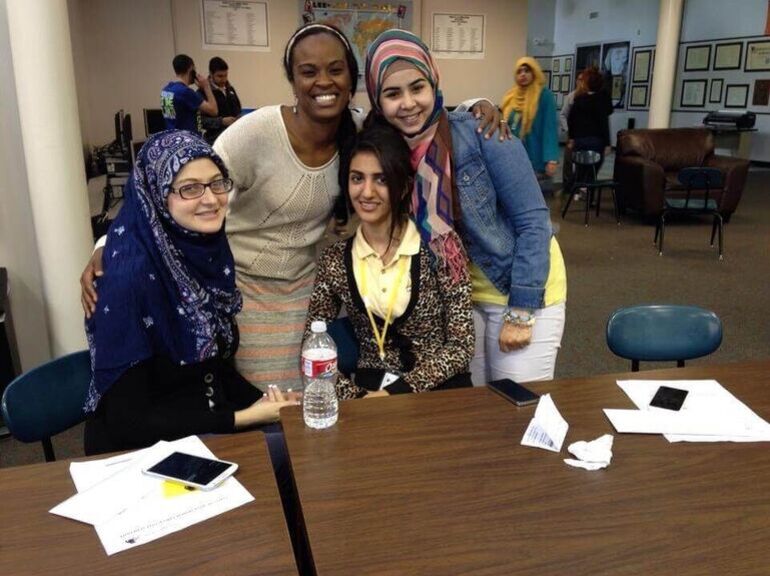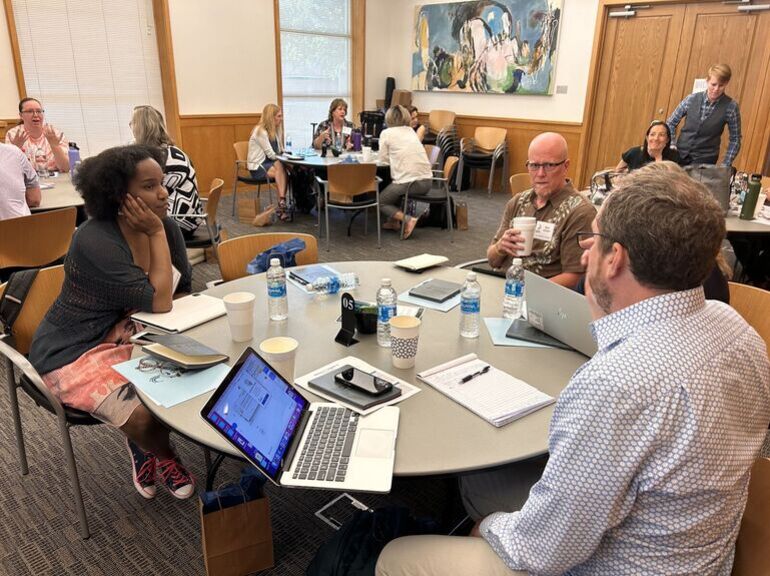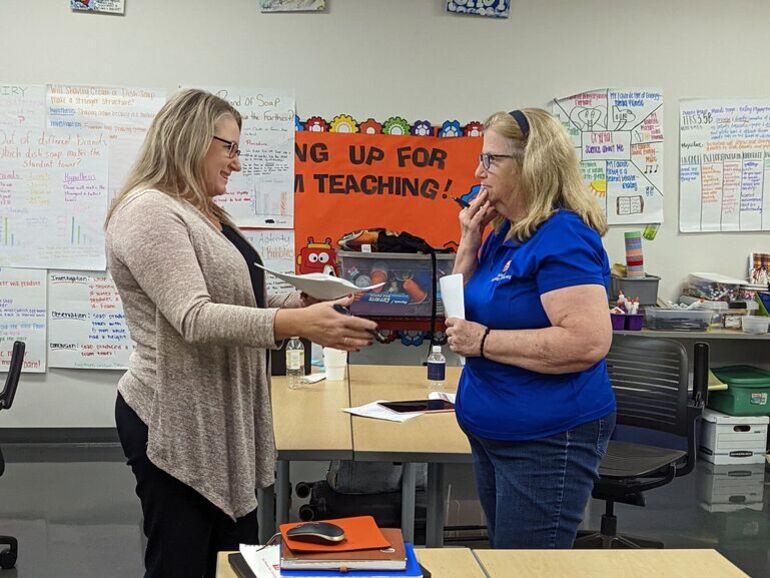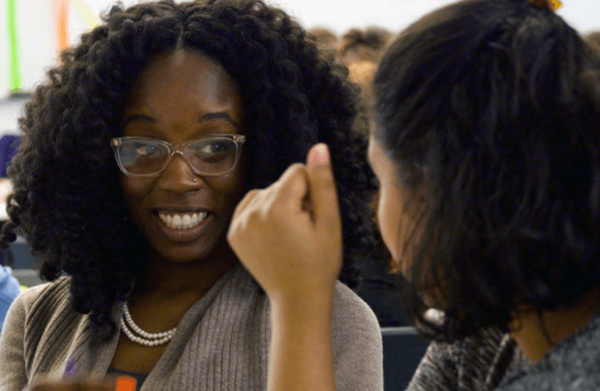Posted on
Empowering clinical supervisors as instructional coaches
Categories: Cognitive Science, Learning by Scientific Design
As a former science teacher, I distinctly remember my teacher preparation experience being rushed. Due to the shortage of science teachers, I was hired on the spot with the promise of being trained on-the-job. With limited preparation, I found myself creating lessons that felt comfortable for me, but were very surface-level and insufficient in effectively engaging all my students in the rigorous learning experiences they deserved.
While I received high ratings from my clinical supervisor, they were often based on minimal observation, focused primarily on classroom management, and included little actionable feedback for instruction. What I truly needed was direct feedback on how to cultivate a more equitable learning environment for my students, rather than obtaining skills to keep students on task and teachers in compliance with their appraisal rubrics.
My preparation experience is not uncommon among novice teachers today. To better support and serve students, we must work towards a different reality: one where my clinical supervisor’s goal would’ve been less about getting me into a classroom with a handful of crowd control skills, and more about ensuring I was well-equipped with evidence-based practices that inclusively engaged every learner from day one. What if I regularly received aligned feedback with a set of equitable learning principles informed by a deep scientific understanding of how students learn rather than how they comply? What if the feedback given focused instead on the “why” behind implementing a pedagogical skill in a particular way so I could more consistently enhance each of my student’s learning experiences?


Over the last four years, DFI’s Learning by Scientific Design (LbSD) Network has been curating this different reality for future teachers through collaborating closely with 10 educator-preparation program teams across the country. We support programs to redesign coursework and clinical experiences for burgeoning educators in order to ensure that teacher-candidates not only understand basic principles of learning science but are also prepared to apply them effectively to create meaningful learning experiences for students. This effort sought to bridge the gap between a theoretical understanding of the learning science principles and the practical application of those principles. In other words, aspiring teachers are both learning the “why” behind important skills and getting practice to actually enact them with feedback.
One of our key aims was to translate hypothetical “what if” scenarios into actionable and achievable objectives for clinical supervisors, something that our VP of Program Dr. Amber Willis and I played key roles in. Supervisors were given essential tools and resources to carry out valuable observations, recognize effective methods for providing focused feedback, and engage in coaching that promotes the equitable implementation of two fundamental learning science principles and teacher actions:
- Deepening Meaning and Learning: Students should think about meaning when they encounter to-be-remembered material.
- Connecting the Dots: Students learn new ideas by referencing ideas they already know.
Clinical supervisors in the network were able to help candidates navigate the complexities of teaching and learning while also considering the crucial aspects of equity. Jolene Reed, an associate professor and clinical supervisor at Sam Houston State University (SHSU), has actively participated in the LbSD Network for the past three years. During the initial two years, she focused on enriching her understanding of learning science principles; as a collective decision along with her teammates, Reed focused her attention on Connecting the Dots. She diligently revised the coursework for her students, and she successfully implemented it within her course to better support future teachers to effectively enact rigorous and equitable instruction.

Let’s look further at how her clinical practice was impacted by the professional learning she acquired, alongside the coursework she provides, within the focus of her classroom observations, and the structure and content of her follow-up coaching conversations.
1. Supporting shared language and understanding among students of science of learning principles
Within the coursework provided to candidates at SHSU, it was essential for Reed to ensure the development of a shared understanding around the learning science principles with a specific focus on Connecting the Dots (also referred to as: Prompting Connections to Prior Knowledge). Therefore, in her course, she made sure candidates understood that every student who comes into their class has a unique set of background knowledge based on their prior schooling and lived experiences. So, when planning a lesson, teacher-educators should be explicit around the following:
- How prior knowledge helps students gain new knowledge.
- Why it is important for candidates to activate relevant prior knowledge for students when introducing new concepts.
- The importance of prompting students to make connections to relevant background knowledge and how that’s related to creating equitable outcomes for all students.
By making this shared language and understanding explicit within the coursework, Reed was able to provide effective feedback to her candidates during her classroom observations.
2. Focusing on specific actions in observations – and identifying common pitfalls – to debrief with candidates in coaching conversations
One of the first changes in Reed’s supervising practice was the lens she used while observing candidates. Instead of looking for a multitude of items, she now went in looking for two essential things:
- The ways candidates deepened the meaning of learning for students, and
- How candidates connected the dots to previously learned ideas for students.
Reed describes, “When I walked into a classroom, I knew what my plan was and what I was looking for. DFI has helped me realize that while that’s good, perhaps I need to look a little more closely and a little more specifically about what I am seeing the candidates do in the classroom.” Supervisors were given a set of criteria to look for the ways that candidates were supporting students to connect the dot. These criteria include:
- Relevant knowledge: help students to identify and pull up important, relevant prior knowledge that is specific and narrowly targeted.
- Schema: make schema (structure of and relationships among concepts) explicit, so students see and use connections between concepts.
- All Learners: structure prompts so that ALL learners have a chance to activate prior knowledge.
A focused lens allows the supervisors to assess the candidates’ understanding and application of the principle Connecting the Dots. Supervisors experienced being consistent in their observation approach, which in turn allowed candidates a cohesive and comparable experience across the program.
Reed stated that across SHSU’s School of Teaching and Learning, “we’re developing a common language that describes good teaching, so when someone says connect the dots…we all know what we’re talking about and we all understand.” Supervisors’ unified way of observing candidates empowers them to achieve multiple objectives:
Firstly, it enables the supervisor to focus their attention on candidates’ teaching practices.
Secondly, it allows for observation through a specific lens that is aligned with a learning principle.
Lastly, this unified approach fosters an affirming learning environment for students and teachers.
Reed’s beliefs about coaching candidates through the lens of the Connecting the Dots principle helped her provide pinpointed feedback that aligns with the language the candidate is hearing in the methods course. Yet just telling a candidate what to do isn’t sufficient – clinical educators must prompt candidates to think deeply about their practice, and that only comes when they provide directed feedback.
During Reed’s post-observation conversations, she’ll ask direct questions such as:
- “Why did you pick on that student to answer that prompt?”
- “What schema are you trying to connect to?”
- “How are you activating your students’ prior knowledge during your lesson?”
There are also common pitfalls that novice candidates fall into when teaching, including the method of “taking hands.” This method involves engaging only a few students, typically those with raised hands, while excluding other students from the opportunity to activate prior knowledge. Reed mentioned that she often sees candidates taking hands, but also calling on the same student for everything: In one coaching conversation when she asked about this instructional practice with a candidate, they responded, “I chose that student because he’s a really sharp student, and he knows all the answers.”
In response, Reed shared: “I offer her a moment of rehearsal during the post-conference, where we practice how we will call on all students or give all students an opportunity to activate prior knowledge. All of this work is done with the three key criteria being the focal points. My feedback becomes valuable when a candidate can think about how allowing each student to activate prior knowledge benefits the learning environment.” Reed’s response created an opportunity for the candidate to engage in reflection and think deeply about that instructional choice. By prompting the candidate to consider the potential negative impact of their instructional move on students who were not given a chance to demonstrate their activation of prior knowledge, Reed encourages a thoughtful examination of the consequences.
3. Providing ample opportunities for candidates to practice and rehearse feedback
Another beneficial change in Reed’s approach involved providing candidates with opportunities to rehearse and refine areas that needed improvement. Providing candidates with a chance to reenact a teaching move was valuable to candidates’ instructional development. Reed explained, “If you incorporate the rehearsal portion into the post-conference, it becomes valuable when you say, how might that sound in the classroom if you do this? ….how does that feel when it comes out of your mouth? I think that becomes very important to help them actually break a habit. For example, instead of saying, ‘Let me see, who knows the answer?’ they try out turn and talk. And [I ask them] how does it feel in your mouth to form those words.”
Rehearsals allow candidates to internalize and put their supervisors’ feedback to use immediately. Additionally, the supervisor is able to help candidates understand the significance of why implementing a different move supports student learning.
“This work has not been easy,” reflects Reed. “But good things aren’t always easy, and so sometimes if we stick with it, we can start to see the value of where this is coming from and realize that the time spent in this work is well with the time that it takes.”
Over the last few years, the reality that we imagined for clinical supervisors like Reed benefited the alignment needed to support effective coaching practices for candidates. Similar to teachers, clinical supervisors are committed to ongoing growth, development (if the professional development is given), improvement, and aiming to enhance their coaching practices. By leveraging the learning science principles, clinical supervisors were able to give targeted feedback, acquire new strategies, and deepen their own understanding of effective instructional decisions their candidates should make–ensuring that future teachers are well-prepared to engage all students in rigorous, equitable, and inclusive learning from day one of leading a classroom.

Related Stories:


Blog
Turning teacher preparation into a team sport
Sisters Venus and Serena Williams are two of the world’s most accomplished athletes. And though...
November 18, 2021

Blog
A coach for the coaches
Usually, coaches are the experts at dispensing strategy and advice.
October 05, 2021
